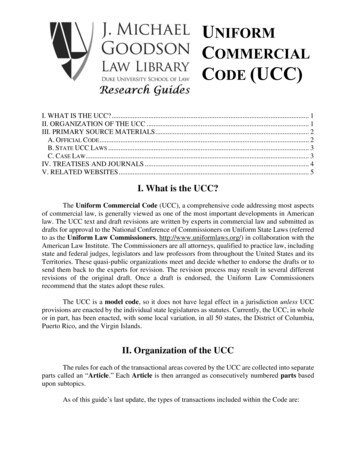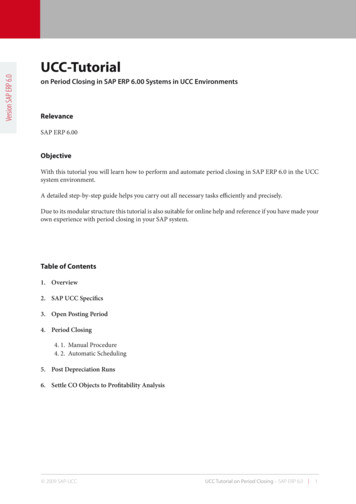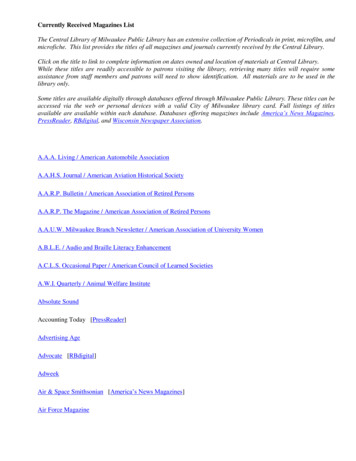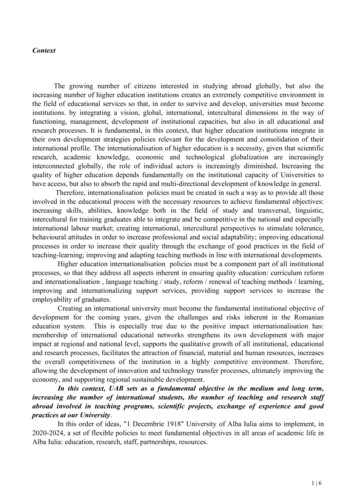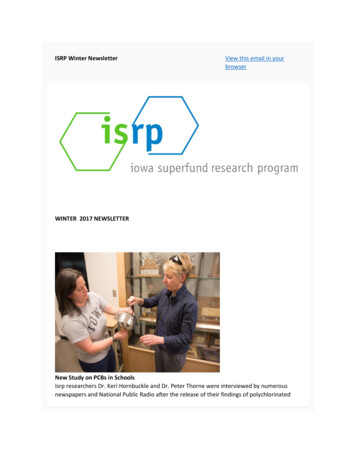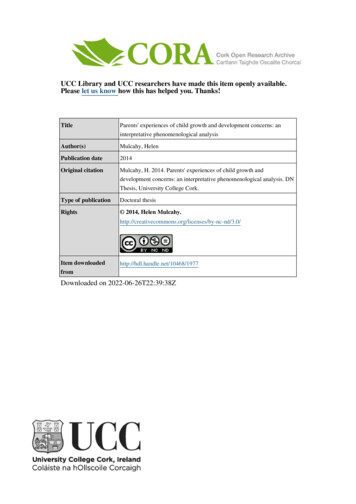
Transcription
UCC Library and UCC researchers have made this item openly available.Please let us know how this has helped you. Thanks!TitleParents' experiences of child growth and development concerns: aninterpretative phenomenological analysisAuthor(s)Mulcahy, HelenPublication date2014Original citationMulcahy, H. 2014. Parents' experiences of child growth anddevelopment concerns: an interpretative phenomenological analysis. DNThesis, University College Cork.Type of publicationDoctoral thesisRights 2014, Helen Mulcahy.Item oaded on 2022-06-26T22:39:38Z
Parents’ experiences ofchild growth and development concerns:An Interpretative Phenomenological AnalysisHelen Mulcahy95200207March 2014This thesis is submitted for a Doctor of Nursing Degree fromThe National University of Ireland, CorkUniversity College CorkCatherine McAuley School of Nursing and MidwiferySupervisorsProfessor Eileen Savage, Chair of Nursing and Head of School of Nursing andMidwifery, UCC.Dr Rhona O’Connell, (Co-supervisor) School of Nursing and Midwifery, UCC
Table of ContentsTable of ction1Chapter 1: Background to child growth and development6Prevalence of developmental delay and disorders9Consequences of growth and developmental delay10Managing growth and developmental delay11Chapter 2: Empirical and conceptual literature review16Introduction16Search strategy16Empirical perspectives of parental concernSource of parents’ concerns1717Timing of the onset of parental concern24Parents perceptions about child growth and development28Parents’ experiences of seeking help and expressing a concern36HCPs’ practices in eliciting and attending to parental concern46Conceptual and theoretical perspectives on parental concernUncertainty in Illness Theory5656Lay Knowledge59Help-Seeking behaviour62Summary and conclusion64Chapter 3: Methodology and methods67Aim67Definition of terms67Research design68i
Ontological and epistemological stance69Phenomenological considerations72Interpretative Phenomenological Analysis (IPA)74Study Sample76Access and recruitment of participants78Data collection procedures80Ethical considerations83Analytical techniques84Methodological rigourReflexivity8994Summary96Chapter 4: Findings98Characteristics of 105Antony and Donna105Felicity105Siobhán106Background context106The concern –‘telling it as it is’106Referred onThe process of referral110111ii
Waiting for the outcome112Superordinate themes114Uncertainty “a little bit not sure”Appraising the concern116116Watching for a while116Making comparisons –“Barometer”118Assessing child doing other things121Puzzling-“Is there something wrong?”124Wondering about the cause125Parental knowledge –‘Being and getting in the know’‘Being in the know’Seeking information –“just Google”126127128Triggers to actionUsual disposition – to panic or not to panic131131Seeking affirmation from family134Seeing the child’s vulnerability138Impact on the child138Others noticing the problem139Time passing142Getting child’s problem checked outJust check it out145145Better safe than sorry145Concern mentioned in passing147Getting into the health system, public or private149In the hands of the professionals152Professional validation152Therapeutic relationships154Summary157Chapter 5: Discussion159Experiences of ‘The Concern – telling it as it is’ and being ‘Referred on’159Uncertainty – ‘a little bit not sure’162Parental Knowledge – ‘being and getting in the know’168iii
Triggers to action171Getting the child’s problem checked out177Strengths and ences196Appendices210TablesTable 3.1 Adherence of study to methodological rigour .91Table 4.1 Biographical and relevant details of parents and children of concern . 100FiguresFigure 3.1 Diagrammatic representation of IPA analysis steps . 87Figure 4.1 Diagrammatic representation of themes .115AppendicesAppendix 1. Written permission from DPHNs to access clinical sites. .211Appendix 2 Ethical approval.212Appendix 3. Cover letter to potential participants .213Appendix 4. Study Information Leaflet for Parents. .214Appendix 5. Consent by subject for participation in research protocol .215Appendix 6 Interview Schedule .217Appendix 7 Convention for transcription of audio files. . 218Appendix 8 Wordle of Muriel’s transcript . 219Appendix 9 Gantt chart . 220Appendix 10 Screenshot of analysis log from NVivo .221Appendix 11 Screenshot from NVivo 26th May 2013 .222Appendix 12 Table of themes for Uncertainty – “a little bit not sure” .223Appendix 13 Table of themes for Parental Knowledge – Being and Getting in the know .224Appendix 14 Table of themes for Triggers to action .225Appendix 15 Table of themes for Getting child’s problem checked out .226iv
DeclarationI declare that while registered for the degree of Doctor of Nursing (DN)I have not been a registered candidate or enrolled student of any other awardat another academic or professional institutionHelen Mulcahy95200207I declare that the content of this thesis is all my own work. Where the work ofothers has been used to augment it has been acknowledged and/or referencedaccordingly.SignedDatev
AbstractBackground: Assessing child growth and development is complex. Delayedidentification of growth or developmental problems in children until school entry hashealth, educational and social consequences for children and their families. Healthcare professionals (HCPs), including Public Health Nurses (PHNs) work with parentsto elicit and attend to their growth and development concerns. It is known thatparents have concerns about their children’s growth and development which are notexpressed to HCPs in a timely manner. Measuring parental concern has not beenfully effective to date and little is known about parents’ experiences of expressingconcern about their child’s growth and development.Aim: To understand how parents make sense of child growth or developmentconcerns.Method: The study was qualitative using Interpretative Phenomenological Analysis(IPA). A purposeful sample of 15 parents of pre-school children referred by theirPHN to second tier services was used. Data were collected by semi-structuredinterviews which were audiotaped and transcribed. NVivo version 10 was used fordata management purposes. Data were analysed using IPA.Findings: Findings yielded two contextual themes which captured how parentsdescribed The Concern – ‘telling it as it is’ and their experiences of being Referredon. Four superordinate themes were found which encapsulated the Uncertainty – ‘alittle bit not sure’ of parents as they made sense of the child’s growth anddevelopment problems. They were influenced by Parental Knowledge – ‘being andgetting in the know’ which aided their sense-making before being prompted byTriggers to action. Parents then described Getting the child’s problem checked out asthey went to express their concerns to HCPs.Conclusion and Implications: Parental expression of concerns about their child is acomplex process that may not be readily understood by HCPs. A key implication offindings is to reappraise how parental concern is elicited and attended to in order topromote early referral and intervention of children who may have growth anddevelopment problems.vi
DedicationTo Ann,My anam caravii
AcknowledgementsI would like to thank my supervisor Professor Eileen Savage, whose expertise inqualitative research and child health assisted, supported and guided me through to thecompletion of this study.To my co-supervisor Dr Rhona O’Connell, thank you for your guidance and support.To Professor Geraldine McCarthy, your inspiration at each step of my academicjourney started back in 1994 and I thank you for it.I would like to thank my fellow doctoral student colleagues. It was encouraging andreassuring to undertake this journey together.Thanks to all the Public Health Nurses in HSE South who assisted in any way eitherthrough helping me access the sample of parents or by being generally supportive.To my parents Joe and Edith thank you for always being so understanding,encouraging and supportive.I would like to thank my family, friends and colleagues for tolerating my absence,distractibility and general grumpiness over the last three years. I promise to make upfor it.To my partner Ann who was there from the very beginning of this doctorate journey.Your love and support kept me mentally and physically healthy, by being with me,never doubting me and reminding me about the light at the end of the tunnel. I got tothis point because of you.Finally I would like to thank all the parents who gave of their time to take part in thisstudy and who shared so much of their personal experiences. It would not have beenpossible without them and I will do as much as I can to ensure their voices are heardwidely and make a difference.viii
IntroductionThe total population of pre-school children in Ireland is 356,329, representing 7.76%of the population (Central Statistics Office 2011). As a consequence, preventativechild health services in Ireland are very important to the nation’s health. Theseservices are organised and delivered through a programme of Child HealthScreening, Surveillance and Health Promotion (CHSSHP). This universal service toall children and their families is provided from birth to the end of the school-goingperiod. In line with international best evidence this programme was reoriented inrecent years (Denyer et al. 1999, Health Service Executive 2005a) from one focusedon developmental screening to a Developmental Surveillance (DS) model. DS isdefined as:“a flexible, continuous process whereby knowledgeable professionals perform skilledobservations of children during the provision of health care. The components ofdevelopmental surveillance include eliciting and attending to parental concerns,obtaining a relevant developmental history, making accurate and informedobservations of children and sharing opinions and concerns ”(Dworkin 1989p.1001).The main purpose of DS is to assess child growth and development so that deviationsfrom the norm, which may indicate developmental delay, developmental disorders orgrowth disorders, are identified as early as possible. While growth or developmentaldelay may not be permanent, it can be the basis or marker for subsequent growth ordevelopmental disorders. Among these are autism, cerebral palsy, speech andlanguage disorders, intellectual or learning disabilities, hearing or vision impairmentor growth disorders such as failure to thrive (FTT) (Lü et al. 2011, Olsen et al. 2007,Sices 2007, WHO and UNICEF 2012).Child development is defined “as the processes underlying the change in growth and1
capability in the child” (Empson and Nabuzoka 2004 p. 36). Assessing childdevelopment is vitally important because it is a critical indicator of health. Between5% and18% of children have some form of developmental delay, disorder ordisability (Center for Disease Control and Prevention 2013, Health Service Executive2005b, NICE 2012, Shevell et al. 2001, Sices 2007, Simpson et al. 2003, WHO andUNICEF 2012). Only 30% to 50% (Glascoe 2001, Glascoe et al. 2006, Sand et al.2005) of developmental/behavioural disabilities are identified before going to school.The optimum period for early intervention is in the pre-school period (Sices 2007).This means a sizeable proportion of children are starting school with unidentifiedgrowth and developmental delays which can affect their health, educational andsocial well-being as well as causing distress and worry for their families (NICE2012). It also means undiagnosed developmental problems are of great public healthsignificance. As effective developmental surveillance hinges on eliciting andattending to parental concern it follows that parental concern is of significance to notonly child health at the individual and family level but to population health generally.The population of interest in this study are pre-school children and their parents.In Ireland the CHSSHP model has a schedule of seven developmental surveillancevisits, from birth to 11 years, involving Public Health Nurses (PHNs) and parents. Itcould be argued that at a very basic level, all the components of developmentalsurveillance as defined above cannot occur unless parents and their children engage,either at home or in clinics with Health Care Professionals (HCPs). Parents arewidely acknowledged as having expert knowledge in judging their own children’sgrowth and developmental progress (de Geeter et al. 2002, Department of Health2009, Health Service Executive 2005a). If this is not to be perceived as rhetoric, they2
have a major role in recognising any growth and development problems. Workingwith parents to identify developmental delay is of great importance to public andcommunity health nursing (Hawkins-Walsh and Stone 2004, NICE 2012). In Irelandthe training for PHNs and Public Health Doctors stresses working with parents andeliciting and attending to parental concern about child growth and development atevery therapeutic opportunity (HSE 2005). However, this is not always prioritised incountries where there is an absence of health care governance to manage infantdevelopmental needs (Leech et al. 2007). Child health services in other countriessuch as the United Kingdom (UK) and United States of America (USA) have beenrecently reviewed (American Academy of Pediatrics 2008, Department of Health2009). Addressing the deficits in the healthcare needs of children in Ireland requires“the development of an integrated national programme for child health” underpinnedby best available evidence (Kilkelly and Savage 2013 p.49).Evidence suggests significant under-detection of developmental delay with childrennot being identified in a timely way (American Academy of Pediatrics 2008, Sand etal. 2005, Sices 2007). This was the initial trigger for interest in exploring andresearching this topic in the current study. Delayed identification of developmentaldelay in children until school entry is a global concern for those who providepreventative child health services. There is a view, mainly from the USA that thesolution to the problem of delayed identification of developmental delay lies inimproving screening tools for systematic developmental screening1 (Sices 2007,Sices et al. 2008). The main argument stems from the view that paediatricians’ timeis limited and there is value in having a parent complete a screening tool such as the1Developmental screening is defined as “systematic use of a validated screening tool to identifychildren likely to have a developmental delay, with all children in a practice or population regardlessof risk” (Sices 2007 p.18)3
Paediatric Symptom Checklist prior to the consultation so that the focus of thediscussion can be on the specific issues identified (Glascoe 2002, Hacker et al.2006). In contrast, preventative efforts based on a developmental surveillance modelare favoured in other countries such as the UK and Ireland. Restall and Borton(2010) believe that not enough is known about all potential risk factors of poordevelopmental outcomes for children to adopt a targeted screening approach.Consequently, universal surveillance is preferred over targeted screening tomaximise the potential of identifying children who need additional assessment andaccess to early intervention. In support of screening, Sices (2007) suggests that anynegative consequences such as increased parental anxiety can be addressed. Notably,this is the only mention of parents by Sices (2007) in her recommendations forscreening practices at that time in the USA.Evidence supports HCPs carefully eliciting parental concerns to detect the type andlevel of concerns raised to allow implementation of the appropriate intervention(Beauchesne et al. 2004). Knowing what will encourage and facilitate parents toexpress concern about child growth and development, and how they express theconcern may facilitate earlier referral to early intervention and may ultimatelyimprove child and parental outcomes (Ellingson et al. 2004, Poon et al. 2010).Therefore, the aim of this study is to understand how parents make sense of childgrowth or development concerns.Firstly in chapter one the background context of child growth and development willbe described in terms of definitional aspects, the prevalence of growth anddevelopment problems, the consequences of child growth and development delay and4
managing child growth and development. This chapter will serve to contextualiseparental concern.In chapter two a review of the empirical literature will be undertaken to exploreparental concern in the context of child growth and development. The search strategywill be described followed by an evaluation of literature relating to: the source andtiming of parental concern; parental perceptions and experiences of concern; andHCP practices in terms of eliciting and attending to parental concern. Also in chaptertwo conceptual and theoretical literature relating to uncertainty, lay knowledge andhelp-seeking will be introduced. This literature review chapter will end with asummary and conclusion of the state of knowledge about parental concern.Chapter three will detail the ontological and epistemological considerations as wellas the methodology and methods used in the study. A rationale for the use ofInterpretative Phenomenological Analysis (IPA) will be provided along with detailsrelating to sample, access, data collection, ethical considerations, analysis and rigour.The findings will be presented in chapter four and will be organised according to thecharacteristics of the sample, the background context and the four superordinatethemes. In chapter five the findings will be organised according to the foursuperordinate themes found and will be discussed in the context of the existingempirical and conceptual literature. The thesis will conclude with a section ofstrengths and limitations, the final conclusion and implications for education,practice, research and policy.5
Chapter 1: Background to child growth and developmentChildren develop dynamically from infancy to adulthood, from dependency onparents and caregivers through to independence. They grow and develop rapidly,through a series of milestones or steps, often in spurts, in infancy and the preschoolyears. The acquisition of child development skills in physical, cognitive, behavioural,emotional or social areas follows a normal distribution. However, the pace andvariation of normal child growth and development makes assessing childdevelopment a complex issue. It has been likened to measuring a ‘moving target’(Marks et al. 2008). Even experienced clinicians have difficulty assessing normalgrowth (Wright and Weaver 2007) but especially with identification of subtledevelopmental problems (SDP)2 (Caronna et al. 2007, Glascoe 2000b, Poon et al.2010). Diagnosing physical disabilities like hearing impairment and cerebral palsywere the key questions 30 years ago whereas more subtle problems like autismspectrum disorders (ASD) are seen as the new ‘frontier’(Caronna et al. 2007). Theystated that it is quite challenging for paediatricians to recognise those children whoneed prompt referral and intervention versus those “for whom ‘watchful waiting’ isappropriate” (Caronna et al. 2007 p.407). However relationships with parents can bestrengthened by HCPs acknowledging the uncertainty (Caronna et al. 2007).Developmental delay is defined as a failure to acquire a particular developmentalskill in one or more linked developmental domain (sensory-motor, cognitive,communication and social-emotional) at an age when 95% of peers have done so(Haddad et al. 2000). Alternative definitions of significant developmental delay2Subtle Developmental Problems (SDPs) was first used by Williams and Holmes (2004) as anoverarching term to describe mild developmental delays and deviations e.g. poor muscle tone,clumsiness, speech delay, behavioural problems and short attention span.6
include a discrepancy of 1.5 to two standard deviations from the mean in one domainand global delay in two or more developmental domains (Poon et al. 2010, Sharma2011). Alternative terms such as Specific Developmental Disorders (SDD) andPervasive Developmental Disorders (PDD) are also used, with the former beingdescribed as delay in one domain and the latter as delay in multiple functions,including communication and socialisation (Rispens and van Yperen 1997, WHO2010).In addition to developmental delay, a variety of other diagnostic classifications areused. For example, the International Classification of Diseases and Related HealthProblems -10th Revision3 (ICD-10)(WHO 2010) lists category R62 as ‘lack ofexpected normal physiological development’ with subcategories of ‘R62.0 delayedmilestone’ and ‘R62.8 other lack of expected normal physiological’. The former‘R62.0 delayed milestone’ is described as including late talkers and late walkers.The latter ‘R62.8 other lack of expected normal physiological’ includes failure tothrive and gain weight, infantilism-not otherwise specified, and ‘lack of growth’ and‘physical retardation’. While these terms combine growth and development they alsoreflect that the term ‘delay’ may be insufficient, as there may also be deviationsrather than delay to the typical sequence of development. For example, children whohave cerebral palsy may roll over earlier than expected because of increased muscletone or there may be dissociations4 and regressions5 (Poon et al. 2010). According toPeterson et al. (1998) the term developmental delay is often used loosely to imply3The International Classification of Diseases (ICD) is the standard diagnostic tool for epidemiology,health management and clinical purposes. It was endorsed by all WHO member states. (WHO 2010)4Dissociations are widely varying rates of development in different domains e.g. typical gross motorbut significant language delay in children with Autism5Regression indicates loss of previously acquired developmental skill and is a serious neurologicalsign. (Poon et al. 2010)7
any kind of developmental problem, or temporarily until a child is old enough to bediagnosed with mental retardation6. They suggest this may be because thecomplexity of neurodevelopment in humans precludes the adoption of a singleclassification system that meets all needs (Petersen et al. 1998). Hence the termdevelopmental delay is widely used in the literature and has a certain acceptedresonance with child health researchers despite its aforementioned limitations. Thecomplexity of identifying developmental delay exists because the types of delay canvary and up to one third of referred children have multiple needs potentiallyindicative of more serious disorders (McKay et al. 2006).Delay may be a marker or initial sign for more serious disorders such as thosecategorised in Disorders of Psychological Development in section F80-F89 of theICD-10 (WHO 2010). These disorders have a number of characteristics in common:their onset is during infancy or childhood; the delay is sharply related to biologicaldevelopment of the central nervous system; and they follow a distinctive coursewithout relapse or remission. Typically, the affected functions include language,motor coordination and visual-spatial skills. Two broad categorisations are evidentfrom the ICD-10 classification, namely Specific Developmental Disorders (SDD)and Pervasive Developmental Disorders (PDD) each of which will be used hereafterwhere appropriate for ease of understanding. Disorders within the SDD groupinclude specific speech and language disorders; specific developmental disorders ofmotor function such as childhood coordination disorder and dyspraxia; and specificdevelopmental disorders of scholastic skills such as dyslexia. PDDs include6Although still used in the literature the term mental retardation has been replaced by intellectualdisability.8
childhood autism, atypical autism, Asperger’s disease, Rett’s disease, autism-nototherwise specified (NOS) and childhood disintegrative disorder.Prevalence of developmental delay and disordersAccording to the WHO and UNICEF (2012), approximately 15% of the world’spopulation have some form of disability but that it is very difficult to identify preciseprevalence estimates because of variety of definitions, changes in disease anddisorder classifications and the measurements used. Nevertheless two eminentauthors in the field of developmental paediatrics have recently published prevalencefigures (Boyle et al. 2011, Fombonne 2009). It is not possible to do directcomparisons as they have used different methods and measures for differentconditions. Boyle et al. (2011, 2012) calculated an overall disability prevalence of13.9 % for non-institutionalized children aged three to 17 years from the householdsurvey conducted by the census bureau on a sample of 119,368 individuals for theCentre of Disease Control (CDC) in the USA. The diagnoses of various SDDs andPDDs came from parent self-reports. The prevalence rate also included ADHDwhich is not classified as an SDD within the ICD-10 but within a separatehyperkinetic classification. Using a different approach, Fombonne (2009) found thetotal prevalence figure for PDDs as 63.7/10,000. This came from a review of 43epidemiological studies from 17 countries in the years 1966-2008. To summarisefrom the data presented from both sources, 1 in 6 children have a SDD and 1 in 150children have a PDD. Contrary to popular belief, Fombonne (2009) does not believethere is evidence to support an ‘autism epidemic’ but does accept that there isincreasing lay and professional knowledge of ASD and children are now younger atdiagnosis.9
Consequences of growth and developmental delayThe consequences for the child of delayed growth and development identificationand intervention include adverse impact on future academic and social functioning(McKay et al. 2006) and poorer general health status (Hamilton 2006). According toPeterson et al. (1998), outcomes include functional limitations, disabilities andsocietal limitations depending on the aetiology and pathophysiology of the delay.There can also be poor child psychosocial health (Webster et al. 2008) or educationaland behavioural problems (Law et al, 2003).Withdrawn behaviour, sleep problems and aggressive behaviour in the child areassociated with attention problems and have the capacity to cause significant stressesfor parents (Tervo 2010). Global developmental or language delay development inchildren pose multiple parenting challenges including: parenting stress (Baker et al.2005, Webster et al. 2008) impaired parental mental health and family functioning(Baker et al. 2003, Herring et al. 2006). When measured, mothers were found toexperience more stress than fathers (Baker et al. 2005, Herring et al. 2006).There can also be relatively positive consequences to receiving a diagnosis ofdevelopmental disorder. A definitive diagnosis of developmental disorder, albeitdistressing for parents can also be seen as a relief, especially after a period ofsearching, and a starting point for parents to move forward with planning forintervention (Noterdaeme and Hutzelmeyer-Nickels 2010). According to Bailey et al.(2004) earlier identification can put a stop to the ‘diagnostic odyssey’ which entailsemotional and financial costs on parents as they pay numerous visits to HCPsseeking validation for growth and development concerns about their children. There10
are significant consequences with developmental delays and disabilities for societyassociated with the on-going provision of health, education and other supportservices (NICE 2012, Sices 2007). In light of the consequences outlined above forchildren, families and populations, there is evidence to support developmental delayas an important topic for on-going research.Managing growth and developmental delayEarly detection and diagnosis of growth and development delay leads to earlyintervention and management. The WHO and UNICEF (2012) recommends a threepronged approach in relation to support and care of children with disabilities whichare early identification, assessment and early intervention. Paediatricians, publichealth doctors, Health Visitors (HV) or PHNs provide child health servicesdepending on the jurisdiction. In Ireland, PHNs, public health doctors and GPs areencouraged to elicit parental concerns at various developmental stages according tothe recommendations of the C
This thesis is submitted for a Doctor of Nursing Degree from The National University of Ireland, Cork University College Cork Catherine McAuley School of Nursing and Midwifery Supervisors Professor Eileen Savage, Chair of Nursing and Head of School of Nursing and Midwifery, UCC.

